Renewable Energy: Sources, Advantages & Disadvantages- Complete UPSC Notes
Renewable Energy
Renewable Energy Sources
Renewable Energy sources are those sources of energy which are naturally replenished faster than the rate of their consumption.
- India’s massively growing energy requirements makes it pertinent for the country to look for renewable energy resources for its energy security and sustainable development targets. With this view, the government is rapidly pushing towards renewable energy resources.
- The Indian government classifices the sources such as solar, wind, biomass, small-Hydro, hydrogen energy and Waste to energy, among others as the Renvewable energy sources.
- We shall cover solar, wind and small Hydropower in this page, and Biomass, Hydrogen energy and waste -to-energy in the next article
Status of renewable energy in India:
- India has ranked third in renewable energy installation in 2021, as per the renewable 2022 global status report published by REN21 (renewable energy policy network for the 21st century).
- About 42% of India’s total installed power capacity comes from renewable energy sources.
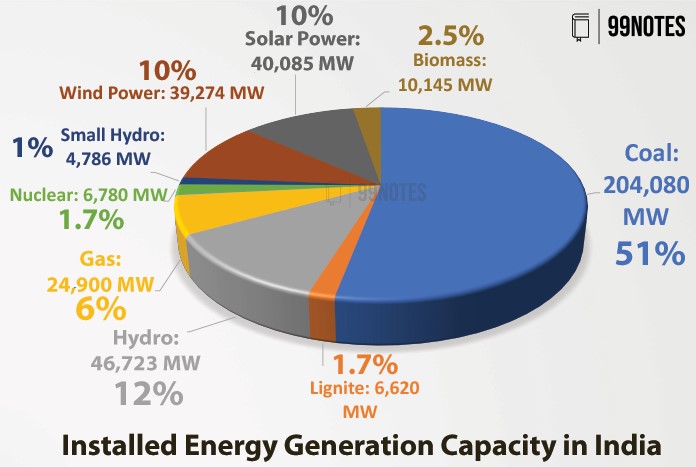
- India ranked fourth in total solar installed power (60.4 GW) for 2021, overtaking Germany.
- As of December 2022, India had 41.8 GW of wind energy and 61.9 GW of solar energy in place, according to the Ministry of new and renewable energy.
- Projects worth $200 billion are underway in India for the renewable energy sector. (as per the International Energy Agency report).
- At present, according to the installed capacity windpower is the leading source of renewable energy in India followed by solar, Bioenergy and small-hydropower.
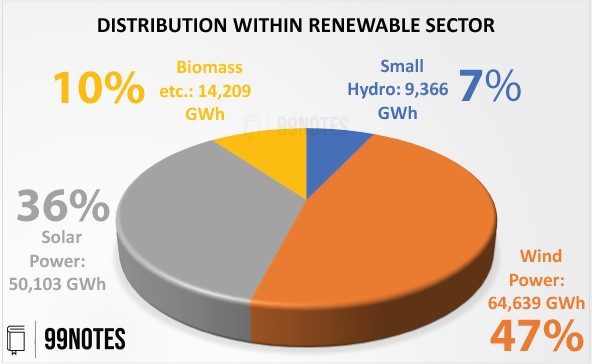
Advantages of Renewable Energy:
- Economic benefit
- Low Long term cost – wind and sun would always be here.
- Low maintenance cost – As there are fewer moving parts.
- Environmental benefit
- Lower pollution Level – Such as almost nil air pollution.
- Land Degradation prevented – For example, it is unlike large hydro where large swathes of land are swallowed.
- Health benefit
- Lesser chance of Industrial Hazards – In Large hydro, there is possibility of flooding, in thermal power plants and nuclear power plants, boiler explosions are a big threat.
- Low Pollution means lesser environmental risks.
- Social benefit
- Environment is a social good. Perverving pastures, forests and natural vegetation is akin to preserving the social structure of the society.
- Moral advantage:
- Its our moral duty to preserve the earth for the future generations.
- “We don’t inherit the Earth from our ancestors, we borrow it from our children”.
However, there are certain challenges that we face in the adoption of Renewable Energy.
Disadvantages of Renewable Energy
- Erratic Production: Both Solar & Wind generation could be erratic. Solar energy production is disrupted in the night or when it is cloudy. Similarly, winds don’t always blow.
- Wafer thin margins: Wind & Solar tariffs have hit such low that margins have become wafer thin. Companies need to be protected from the shocks.
- Long term Power Purchase agreements(PPA) are not suited to renewable energy.
- Domestic Content requirement: Manufacturers of PV Cells face heavy import duty on Chinese PV imports. This makes them expensive.
- Import dependence: India has avery small domestic manufacturing. The domestic cell manufacturing in 2019 was meagre 3.1 GW in
- Rooftop Production: We’ve achieved only 3% of our target of rooftop production of energy. This is because sometimes, rooftop installations might not be economically viable for the home-owners.
- Lack of trained personnel: workers engaged in PV installation are not skilled. It discourages the investment.
- Operational issues: The solar panels used are not designed for very high temperatures. In remote areas such as, in deserts with high temperatures, the panels do not yield their optimal usage.
- Dust is a problem: especially in Rajasthan, which require frequent cleaning and increase the operational costs.
- Hardness of the water: Solar power plants generally exist in desert areas where only hard water is available. But, Hard water is not suitable for cleaning, and companies have to invest in reverse osmosis (RO) and other technology to make it suitable.
It is because of these limitations that despite around 40% of installed renewable capacity, in terms of actual utilization it is just around 25% (including large hydro and nuclear energy).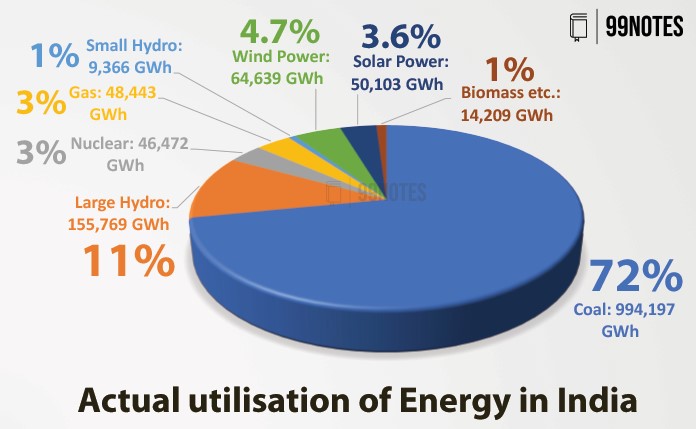
Solar energy:
Solar Energy is the electricity generated using the sun’s energy. Electricity can be generated from solar energy in two ways:
- With the help of photovoltaic cells: Solar energy is made to fall on photovoltaic cells, generating electricity for direct use.
- With solar thermal Technology: a focused beam of sunlight is made to fall on the collector, which generates heat and can be used for multiple purposes. This heat can be channelled through a conventional generator to produce electricity.
India has set a target of generating 500 GW of renewable energy by 2030. However, covering only 3% of the wasteland with solar units can generate 768 GW of power.
Advantages of Solar Energy
India is naturally blessed with long sunny days and a tropical geographical zone. This opens up huge potential for India to tap solar energy.
- Solar Energy is available throughout the day which is the peak load demand time.
- Solar energy conversion equipments have longer life and need lesser maintenance and hence provide higher energy infrastructure security.
- Low running costs & grid tie-up capital returns (Net Metering).
- Zero pollution and generate clean power.
- Abundance of free solar energy in almost all parts of country.
- Less transmission loss – can be produced at demand centres
National Solar Mission
- The government has launched the national solar Mission in collaboration with state governments to increase solar power generation.
- The Solar Energy Corporation of India (SECI) is a PSU which as been made responsible for the implementation of the National Solar Mission. SECI was earlier was known as the Renewable Energy Corporation of India (RECI). It was renamed to SECI to demonstrate the government’s commitment towards the Solar energy goal.
- Development of the National Solar Mission:
-
- The Jawaharlal Nehru National Solar Mission (JNNSM) was launched in 2010 to boost solar production in India with a target of 50GW solar power production in India.
- It was later renamed as the National Solar Mission and was relaunched with a new vigour by the Narendra Modi Government to double the production target to 100GW Solar power by 2022. Of this –
- 60GW was to be produced by Grid connected utility Solar plants, and
- 40GW was to be produced by Grid connected Solar rooftop projects.
- This aim was achieved by 2022.
- New Aim: National Solar Mission now aims to make India a global leader in solar power generation and envisages it to generate 175 GW (target revised from 100GW earlier) of energy through solar power.
International Solar Alliance
- India also played a leading role in the launch of the International Solar Alliance (ISA) in COP21 Paris. The organisation acts as a platform for mutual collaboration among different countries lying fully or partially between the Tropic of Cancer and the Tropic of Capricorn for the growth of solar energy.
- ISA Secretariat is established in Gurugram, Haryana – with the aim to
- To mobilise finances for the development of solar energy.
- To foster research and development and technology transfer in the Solar sector.
- Creation of solar microgrid.
- Promotion of solar power in the agriculture sector.
- ISA’s ‘Towards 1000 strategy’ aims to mobilise USD 1000 Billion of investment in solar energy.
- Proper implementation of programmes of ISA can reduce carbon emissions to the
tune of 1000 million tonnes of CO2 every year.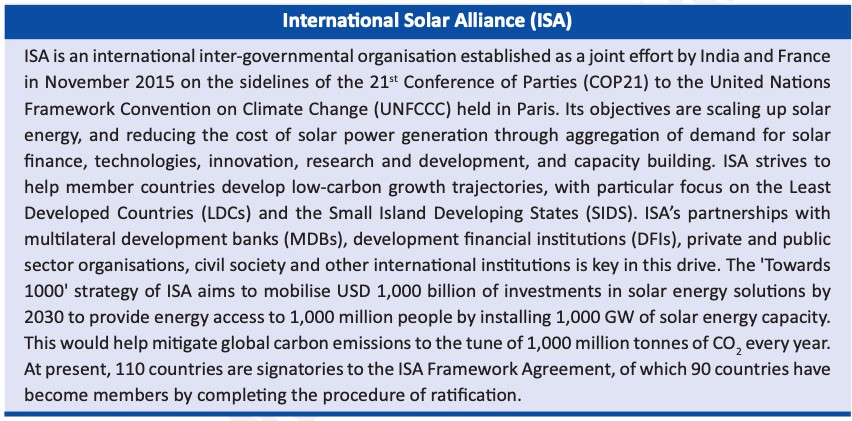
India’s Aim for Solar Power
- India seeks to generate 40,000 MW(or 40 GW) of solar energy through rooftop panels.
- And targets to generate 40,000 MW of solar energy through ultra mega solar Power projects (UMSPP). Solar power projects having a capacity of 500 MW or more are known as UMSPP.
Solar Initiatives taken by the Government
- The Ministry of Renewable Energy has launched SARAL Index (State rooftop solar attractiveness index) to assess the performance of states in solar power generation.
- The government has also introduced a net metering system to promote solar rooftop panels and independent solar power projects.
- The government has also established National Clean Energy Fund (NCEF) to meet the financial needs of the renewable energy sector.
- In the case of off-grid solar power, the government has launched the PM Kusum scheme to meet the energy requirements of the agriculture sector through solar power. The scheme seeks to incentivise farmers to the installation of solar pumps.
- The government is also targeting providing 3 lakh solar street lights and 25 lakh Solar study lamps to promote off-grid solar power. (Economic Survey 2019).
| Rank | State | Solar Capacity | Biggest Plant in State |
| 1 | Rajasthan | 16.06 GW | Bhandla Solar Park |
| 2 | Gujarat | 8 GW | Charanka Solar Park |
| 3 | Karnataka | 7.8 GW | Pavagada Solar Park |
| 4 | Tamil Nadu | 6.2 GW | Kumuthi Solar Project |
|
States with higher solar installed capacity. |
|||
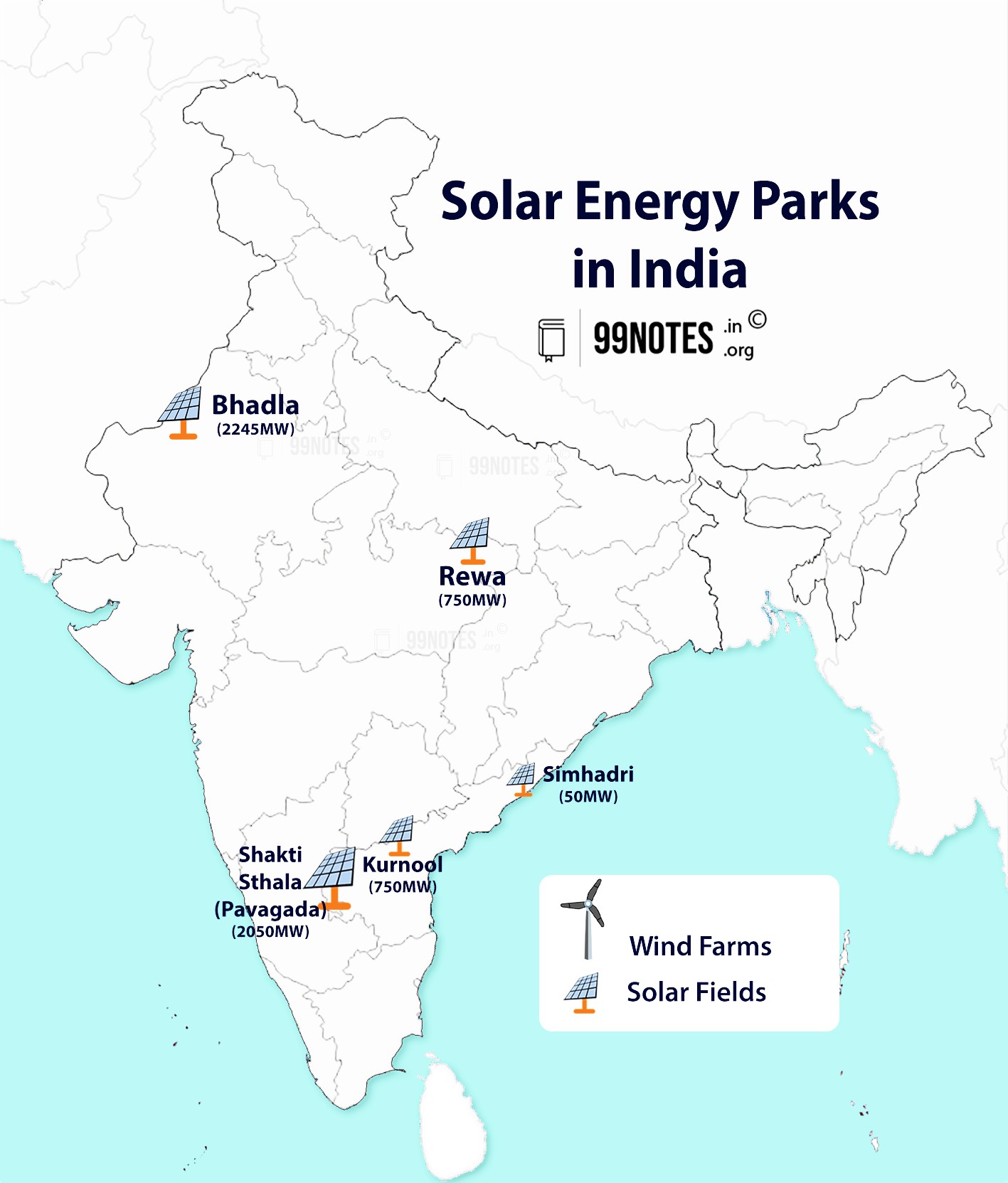 Wind Energy:
Wind Energy:
- The kinetic energy of moving air (wind) is used to rotate the turbines and generate electricity. This Wind turbines convert kinetic energy into mechanical energy, which can then again be translated into more valuable forms of energy, such as electricity.
- India is presently the world’s fourth largest wind power producer, with 38 GW of installed wind energy capacity.
- States like Gujarat, Tamil Nadu, Maharashtra, and Madhya Pradesh provide an excellent opportunity for power generation through wind turbines.
- At present, the sequence of installed wind power capacity is as follows
Tamil Nadu > Maharashtra > Karnataka > Rajasthan
- With 7500 km of coastline, India has great potential for offshore wind energy projects.
Problems of Wind Sector:
- Very high initial investment.
- Traditional long term Power Purchase Agreements(PPAs) have limitations as renewable energy is quickly becoming cheaper. This leads to huge losses on the part of Power purchasers.
- Irregular Energy output: It needs strong regular winds.
- Noise Pollution made by rotatory blades is a cause of disturbance in Residential areas.
- Environmental Concerns: It is harmful for birds. As often flying birds get killed by rotatory blades.
- It is subject to damage from high winds and lightening.
National offshore wind energy policy:
- Under this, the government seeks to establish offshore wind energy projects in India’s exclusive economic zone (EEZ).
- The government has set an aim of generating 30 GW through offshore wind energy projects by 2030.
- Advantages of the offshore wind Energy:
- Greater area for setting up large projects.
- Higher wind and consistent speed resulting in more electricity generation.
- Less visual impact: As these sites are located far from land they have less visual impact which helps with public acceptance issues.
- Close to load centers: The off-shore wind farms are usually located near to the cities and load centers thus transmission losses are minimised.
- Environmental impact: low global warming potential per unit of electricity generated, comparable to that of onshore wind farms.
- Better use of EEZ
Solar-Wind Hybrid Policy:
- Under this, the government seeks to connect the grids of solar energy and wind energy to reduce the variability in power generation.
- Solar energy and wind energy will complement each other, resulting in reduced power generation fluctuations.
Green energy corridor:
- It is the initiative of MNRE.
- And it seeks to connect renewable energy power generation centres with the conventional grid to provide a consistent power supply even with renewable energy.
| Rank | State | Wind Capacity | Biggest Plant in State |
| 1 | Tamil Nadu | 9.3 GW | Muppandal Wind Farm |
| 2 | Gujarat | 7.5 GW | Mundra Wind Farm |
| 3 | Maharashtra | 5 GW | Brahmanvel Wind Project |
| 4 | Karnataka | 4.8 GW | Tuppadahalli Wind Project |
| States with higher wind installed capacity. (By Dec. 2020) | |||
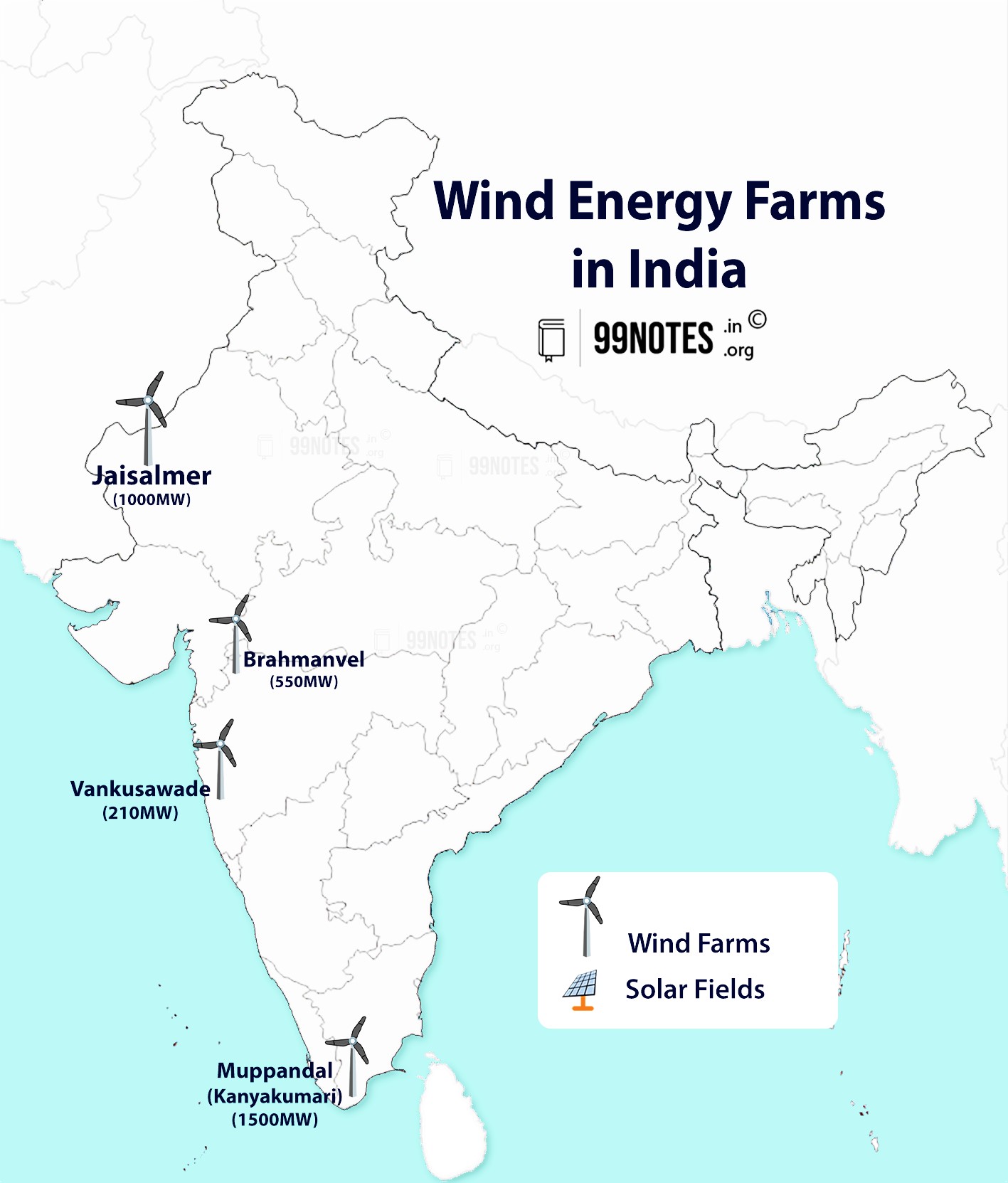
Small-Hydro Power Plants:
Small Hydro are the Hydropower plants with installed capacity of less than 25MW. This is still Quite large, as 25MW is enough to power a small residential town.
- India is 7th largest producer of Hydropower in the world, with installed capacity of 45,699MW. Of this 4683 MW comes from Small Hydroprojects.
- Most of such existing projects exist in Maharashtra, Madhya Pradesh, Telangana & Karnataka.
- However, India’s total Potential to produce small hydropower is 20,000MW or 20GW.
- India’s Ministry of New and Renewabe Energy had aimed that at least 50% of the Small Hydro potential must be harnessed in the country by 2020; However this target has been missed.
- Identified potential lies in the States of Himachal Pradesh, Uttarakhand, Jammu & Kashmir and Arunachal Pradesh ; where 5000MW more can be produced to reach near 10,000MW.
- India aims to generate 5000 MW of energy through small hydropower plants.
Advantages of Small Hydropower projects:
- It can be constructed at the village level and thus can meet power demand in remote locations.
- It generally does not encounter deforestation, resettlement/rehabilitation, which is a big disadvantage of a Large Scale hydropower plant.
- Local production also means less transmission cost.
- It has a long Useful life as is the case with all types of hydropower.
- It helps in other activities such as irrigation, fish-breeding
Constraints of Small Hydropower projects:
- Difficult locations
- Short working seasons, as small reservoirs often dry out in summers.
- Resistance from local communities, as sometimes pasture land submerges.
- Delays in clearances: Multi-department statutory clearances, such as: long acquisition period, forest, irrigation, fisheries etc.
- Inadequate funding.
- Difficulties faced by private sectors: Such as High cost of construction. It takes ₹9 Crore to produce 1 MW of power. Further, the Poor power purchase rates does not support the sale of electricity especially in rural areas.
National Mission on Small Hydro-power:
- National Mission on Small Hydro-power aims to build 5000MW small hydro capacity by 2019 end. It will add only 500 MW in its first two years, but it aspires to build another 4,500 MW of capacity in the next three years.
- Mission targets are:
- Persuade and facilitate all the states to participate in the National Mission of Small Hydro for setting up new SHP projects, provide favourable policy and institutional support for SHP projects by private sector
- Refurbish, Modernize and revise (RMU) of all existing Government sector small hydro projects, if required, and to develop effectiveness and add capacity where ever possible.
- Develop new technologies and engineering solutions to set up low and ultra low head (below 3m) small hydro projects on canals, dam outlets and water outfall structures.
- Projects of 1000 MW on canals and existing water structures by the year 2019.
- Develop a system of water mills, individual household systems and micro hydro projects in remote and rural areas and set up 5000 water mills/micro hydro projects and establishing local mini grids.
Conclusion:
- With recent developments, India is leading the way for sustainable power in the world.
- Due to the inherent benefits of renewable energy, such as zero carbon emissions, cheaper sources of electricity than conventional sources, and new employment opportunities, the government is engaging in developing the renewable energy sector.
- With India’s nationally determined contributions to NDC in the global summits, energy generation through renewable energy is only expected to rise in the future.





![What Is Social Infrastructure: Meaning, Importance &Amp; Challenges [Upsc Notes] | Updated July 27, 2024 What Is Social Infrastructure: Meaning, Importance & Challenges [Upsc Notes]](https://99notes.in/wp-content/uploads/2023/05/social-infrastructure-99notes-upsc-1-768x512.webp)


